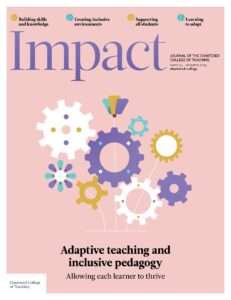Towards a holistic education: Inclusive curriculum design for student growth

STEPH HILL, ECT 1, SPRINGFIELD JUNIOR SCHOOL, UK
DAVID KERSHAW, SENIOR LECTURER IN EDUCATION, UNIVERSITY OF DERBY, UK
In modern education, the imperative for an inclusive curriculum is undeniable. An inclusive curriculum ensures that all students feel valued, represented and equipped to engage critically with their learning and the wider world. However, traditional educational systems often fall short, privileging dominant cultural narratives and a conscious or subconscious overlooking of the contributions and needs of marginalised groups. This perspective piece explores how a curriculum with an inclusive approach – grounded in representation, critical thinking and student agency – can address these gaps.
The current UK National Curriculum: A barrier to inclusivity?
The UK National Curriculum has faced significant criticism for its failure to meet the needs of all students. This issue is multifaceted, with concerns about curriculum narrowing and an overemphasis on test preparation, which can limit the breadth of education (OfstedThe Office for Standards in Education, Children’s Services and Skills – a non-ministerial department responsible for inspecting and regulating services that care for children and young people, and services providing education and skills, 2017), often at the expense of diverse and inclusive learning experiences. Students with special educational needs and disabilities (SEND) are significantly less likely to meet key learning benchmarks, such as phonics and literacy standards (Azpitarte and Holt, 2024), while students from disadvantaged backgrounds consistently fall behind their wealthier peers (Adams, 2024). This overemphasis on outcomes and metrics not only highlights potential structural flaws in curriculum design, but also undermines the Equality Act provisions, which mandate non-discrimination and equitable access to education.
Despite 2014 reforms, the National Curriculum remains extensive, ethnocentric and insufficiently inclusive (Arday, 2020). Its content frequently reflects a Eurocentric and Anglocentric worldview, failing to account for the multicultural realities of contemporary Britain. This lack of representation alienates students from minority ethnic backgrounds. Additionally, it deprives all learners of the opportunity to engage with a more diverse range of cultural and international perspectives, which, as highlighted by Hindin (2024), is crucial for fostering empathy, critical thinking and global awareness.
While the National Curriculum ostensibly aligns with Durkheim’s (1956) vision of education as a means to foster critical thinking, ethical values and societal contribution – and reflects his view of education’s functionalist role in promoting social cohesion and preparing individuals for the workforce – the established subject hierarchy, which prioritises core subjects like mathematics and English, often undermines a rich and varied experience of foundation subjects. These subjects are frequently undervalued, despite their importance in cultivating the imagination, analytical thinking and the empathy necessary for contributing to a tolerant and sustainable world (Lombardi et al., 2021). This prioritisation of subjects, standardised testing and performance metrics undermines any curriculum intent to nurture holistic development (HMC, 2021) or learning dispositions (Claxton, 2018). While the National Curriculum itself does not inherently restrict these opportunities, its implementation – particularly when driven by high-stakes assessment and narrow performance metrics – can create an imbalance that limits students’ engagement with diverse perspectives and their ability to challenge societal inequities. This constraint ultimately affects their capacity to make meaningful societal contributions, grounded in a fully developed ethical and social conscience.
Fearn and Key (2021) use the Jenga tower analogy to explore children’s learning as they move through education. A sturdy tower enables learners to explore more complex, loftier ideas, whereas a pupil with knowledge missing in their tower has a much wobblier foundation upon which to build cognitively. However, extending this analogy, we must consider whether the curriculum design and its implementation under current systemic pressures enable equitable access to knowledge for all children. While the Jenga metaphor indeed supports the importance of foundational skills – oracy, numeracy, literacy and vocabulary – as essential building blocks worthy of focused attention, it also emphasises the dynamic nature of learning, where knowledge can be continuously added and reinforced. The challenge lies in ensuring that these foundational elements are delivered in ways that remain accessible and meaningful to diverse learners, creating towers that can grow steadily over time regardless of students’ starting points.
Addressing this current curriculum imbalance is more than a matter of re-emphasis or rhetoric surrounding schools, their communities or Ofsted inspection priorities. It requires restructuring the curriculum to ensure that all subjects and holistic principles are valued more equitably. Simply increasing time for marginalised subjects is insufficient, as the predictability of assessments drives a focus on what is tested. High-stakes results reinforce this, creating a ‘vicious spiral in which only those aspects of learning that are easily measured are regarded as important’ (Wiliam, 2000, quoted in McConville, 2024, p. 48), limiting the broader moral and social education that is essential for students’ development. To align with Durkheim’s ideals, reform must extend beyond subject allocation to include a re-evaluation of assessment practices, which currently shape teaching priorities and subject hierarchies. Without this, efforts to rebalance the curriculum will remain constrained by the dominance of quantifiable outcomes.
The importance of diverse perspectives, critical thinking and agency in education
While it is now long established that schools engage in a delicate balancing act between a ‘National Curriculum’ and a ‘local curriculum’ (Male, 2012; Male and Waters, 2012), this flexibility allows schools to develop contextually responsive approaches. By adapting curriculum content and delivery to reflect local communities and experiences, schools can create more meaningful learning opportunities that specifically address the needs and perspectives of marginalised children, who might otherwise find limited connection to standardised content. Although proactive schools often manage national and local priorities effectively, it is essential to consider the curriculum through the lens of the most important stakeholders: the children. Schools may state idyllic principles, such as wanting children to become successful learners, confident individuals and responsible citizens; however, if the school experience – including learning environments, relationships and extracurricular opportunities – fails to reflect these ideals, efforts at inclusivity risk becoming tokenistic. Without genuine engagement, learning may continue to be framed as possessing knowledge and as a passive process, rather than an active, critical and transformative experience. When Male and Waters (2012) discuss competency, this is very much from the perspective of a fusion of knowledge, understanding, skills and personal development. Therefore, the school experience must ensure that knowledge is valuable without allowing the pressure for retention to overshadow other valued principles. Children engage more deeply with learning when new information is meaningful and connects to their real-world experiences (Murray, 2022). While learners often make natural connections in exploratory settings, structured academic environments can separate knowledge into rigid subject areas, making it essential to adopt holistic teaching practices that support the transferThe processes of applying learning to new situations of learning across different contexts, to develop mind, curiosity and persistence.
An inclusive curriculum and practice goes beyond tokenistic representations, integrating diverse perspectives throughout the learning process, challenging dominant narratives and offering students a fuller understanding of history, science, literature and society. Traditional curricula often over-represent dominant cultural achievements, while sidelining the contributions of, for example, women, people of colour, Indigenous communities and other marginalised groups. This exclusion perpetuates stereotypes and limits students’ ability to engage with a richer picture of human achievement. Diverse representation matters because it validates students’ identities and experiences, while challenging preconceived notions about who can succeed and contribute to society. High-profile examples, such as the incorporation of scientific contributions from figures such as Rosalind Franklin and Katherine Johnson, alongside and not in replacement of widely recognised names, such as Sir Isaac Newton and Charles Darwin, highlight the often-overlooked roles of women and people of colour in the advances of science. Similarly, exploring colonisation through the perspectives of Indigenous peoples enriches historical understanding. It disrupts Eurocentric narratives, encouraging students to think critically about power, culture, justice and the dynamic nature of the world.
However, inclusionAn approach where a school aims to ensure that all children are educated together, with support for those who require it to access the full curriculum and contribute to and participate in all aspects of school life transcends the mandated topics of curriculum coverage intended to redress representation. Inclusive classrooms foster caring relationships, autonomy and self-efficacy (Hick et al., 2009). Although the work of Hick et al. (2009) centres on special education, the principles they highlight have broader relevance across educational contexts. Teachers can implement inclusive practices within the current curriculum framework through strategic pedagogical approaches, although structural reforms would further enhance their effectiveness. This involves creating meaningful opportunities for all students to engage critically with diverse perspectives and real-world issues. By fostering critical thinking and student agency, educators can empower learners to question biases, appreciate multiple viewpoints and actively participate in shaping their education.
From a social reconstructionist perspective, schools are powerful agents of societal reform, equipping students to challenge systemic inequities and contribute to a more equitable future. This philosophy aligns with the principles of critical engagement and student empowerment, where lessons on contemporary issues, such as environmental justice, provide opportunities for students to examine social inequities and propose actionable solutions. These methods nurture essential skills such as empathy, civic responsibility and social awareness. Interestingly, while the Department for EducationThe ministerial department responsible for children’s services and education in England (DfEDepartment for Education - a ministerial department responsible for children’s services and education in England, 2013) envisions the National Curriculum as a framework for equipping individuals to navigate the economic, social and cultural transformations driven by global integration, its implementation has often placed a strong emphasis on economic preparedness. As highlighted during the Education Reform Summit (Gibb, 2015), education has been framed as a key driver of both personal and national economic development, potentially leading to less emphasis on broader social and cultural engagement, including political deliberation and community involvement.
The way forward: A curriculum that reflects modern Britain
The UK National Curriculum has the potential to become a powerful tool for fostering inclusion and equity, but it requires significant reform. Addressing its current limitations – such as its emphasis on standardisation, its ethnocentric focus and its lack of accessibility – demands systemic change. The Ofsted Annual Report 2021/22 for further education and skills (Joyce, 2023) does show a broadly positive approach to learning, which equips learners for future economic challenges. This focuses on ambitious and challenging programmes, well-ordered curriculums and well-supported teachers. Learners can thrive in a focused, calm and inclusive environment, where positive social interactions and learners’ broader development are considered. Guile and Unwin (2019) highlight that as vocational education and training have been consistently underutilised, this has led to serious deficiencies in skill development and relevancy provision. Should the diverse perspectives of all learners be encompassed in a broad curriculum, this will empower students as agents of change, fostering critical thinking and encouraging them to truly become agents for societal transformation. However, achieving this requires careful curriculum planning. Educators must balance inclusivity with practical constraints, such as instructional time and teacher training needs. One approach is interdisciplinary learning, where subjects are integrated to enhance engagement and real-world application – for example, incorporating ethical debates into science education or linking literature with historical and social issues. These strategies can ensure that critical thinking and social transformation remain central to education without overwhelming existing structures.
Should schools shy away from the flexibility identified by Male and Waters (2012) and fail to embrace the diversityThe recognition of individual differences in terms of race, ethnicity, gender, sexual orientation, socio-economic status, physical ability, religious beliefs and other differences of their school communities and their diverse contexts, then the responsibility of this – or, indeed, the opportunity – falls to the teacher. Developing classroom environments that nurture empathy, equity and a sense of belonging equips students to succeed academically and engage thoughtfully with the world around them, providing them with the security to challenge inequities and envision a better future.
However, teacher autonomy is not absolute; it is shaped by decisions made at higher levels, including school leadership, governing bodies and policymakers (NFER, 2020). Leadership priorities, administrative policies and resource distribution can all influence the extent to which teachers can adapt their classrooms to support inclusion and equity. Ultimately, the flexibility that teachers have in fostering inclusive and equitable learning is only as extensive as the structures that enable or constrain it.
Translating Claxton’s (2018) philosophy into classroom practice, then, requires deliberate structural shifts in how curriculum delivery is approached. For example, when teaching core curriculum knowledge, teachers might implement what could be termed ‘adaptive learning sequences’ – where a single topic is approached through multiple entry points and explored through varied cultural lenses. Here, teachers establish clear academic frameworks while implementing varied teaching strategies that develop Claxton’s learning dispositions, such as resilience, resourcefulness and reflectiveness. These teaching approaches – including structured inquiry, collaborative problem-solving and metacognitive reflection – are distinct from but complementary to the assessment methods through which students demonstrate understanding. For instance, when exploring scientific concepts, the teacher might employ guided discovery and explicit modelling of scientific thinking, while students ultimately demonstrate their knowledge through various assessment formats. This distinction ensures that learning processes foster dispositional development, while assessment methods appropriately evaluate conceptual understanding and skills acquisition with equal academic rigour. This methodology aligns with standardised requirements and inclusive practice, while fostering the independent learning skills that Claxton (2018) identifies as crucial for academic development.
Schools, policymakers and communities can work together to reimagine education, but they must prioritise the creation of a curriculum that celebrates diversity and champions inclusion and then lives this practice – ensuring that every student, regardless of background or ability, feels valued and empowered to contribute to society, ultimately leading to a curriculum that fosters children’s holistic development. The ongoing National Curriculum review offers a key opportunity to embed these values into future reforms.
- Adams R (2024) Poorer high-ability UK children fall behind peers at school from age of 11. Guardian, 24 June, 24. Available at: www.theguardian.com/education/article/2024/jun/24/poorer-high-ability-uk-children-fall-behind-peers-at-school-from-age-of-11 (accessed 2 March 2025).
- Arday J (2020) The Black curriculum: Black British history in the National Curriculum report 2020. The Black Curriculum. Available at: https://diversityuk.org/wp-content/uploads/2020/06/The-Black-Curriculum-Report-2020.pdf (accessed 1 March 2025).
- Azpitarte F and Holt L (2023) Failing children with special educational needs and disabilities in England: New evidence of poor outcomes and a postcode lottery at the local authority level at Key Stage 1. British Educational Research Journal 50(1): 414–437.
- Claxton G (2018) The Learning Power Approach: Teaching Learners to Teach Themselves. Carmarthen: Crown House Publishing.
- Department for Education (DfE) (2013) National Curriculum. Available at: www.gov.uk/government/collections/national-curriculum (accessed 2 December 2024).
- Durkheim E (1956) Education and Sociology. New York: The Free Press.
- Fearn H and Key J (2021) Curriculum: Keeping it simple. In: Ofsted Blog. Available at: https://educationinspection.blog.gov.uk/2021/12/08/curriculum-keeping-it-simple (accessed 7 December 2024).
- Gibb N (2015) The purpose of education. Department for Education. Available at: www.gov.uk/government/speeches/the-purpose-of-education (accessed 3 December 2024).
- Guile D and Unwin L (2019) The Wiley Handbook of Vocational Education and Training. Hoboken, NJ: Wiley Blackwell.
- Hick P, Kershner R and Farrell P (2009) Psychology for Inclusive Education: New Directions in Theory and Practice. London: Routledge.
- Hindin H (2024) What are the benefits of global education for students? Participate Learning. Available at: www.participatelearning.com/blog/benefits-global-education-students (accessed 2 April 2025).
- HMC (2021) HMC survey finds curriculum and assessment is no longer fit for purpose. Available at: www.hmc.org.uk/news/hmc-survey-finds-curriculum-and-assessment-is-no-longer-fit-for-purpose/#:~:text=The%20educational%20system%20does%20not (accessed 4 December 2024).
- Joyce P (2023) What does high-quality curriculum and teaching look like in further education and skills? In: Ofsted: Blog. Available at: https://educationinspection.blog.gov.uk/2023/02/16/what-does-high-quality-curriculum-and-teaching-look-like-in-further-education-and-skills (accessed 7 December 2024).
- Lombardi L, Mednick FJ, De Backer F et al. (2021) Fostering critical thinking across the primary school’s curriculum in the European schools system. Education Sciences11(9): 505.
- Male B (2012) The Primary Curriculum Design Handbook is Preparing our Children for the 21st Century. New York: Continuum International.
- Male B and Waters M (2012) The Secondary Curriculum Design Handbook: Preparing Young People for their Futures. London: Bloomsbury Publishing.
- McConville A (2024) What would a genuinely alternative assessment system look like? In: Renewing Public Education: Proposals for an Inclusive, Democratic and Joyful System, pp. 47–53. Available at: https://lwbooks.co.uk/product/renewing-public-education (accessed 12 March 2025).
- Murray J (2022) Young children’s curriculum experiences. International Journal of Early Years Education 30(4): 627–633.
- National Foundation for Educational Research (NFER) (2020) New study suggests teacher autonomy over their professional development is strongly linked with job satisfaction and retention. Available at: www.nfer.ac.uk/press-releases/new-study-suggests-teacher-autonomy-over-their-professional-development-is-strongly-linked-with-job-satisfaction-and-retention/?utm_source=chatgpt.com (accessed 10 March 2025).
- Ofsted (2017) HMCI’s commentary: Recent primary and secondary curriculum research. Available at: www.gov.uk/government/speeches/hmcis-commentary-october-2017 (accessed 6 December 2024).










